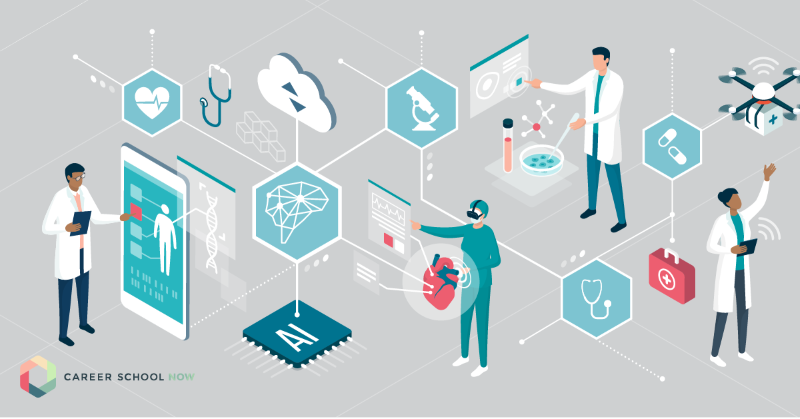Medical Administration Programs: What to Look for in a Quality Course
Medical Administration Programs: What to Look for in a Quality Course
Blog Article
Innovations in Medical Administration: Exactly How Innovation Is Reshaping Healthcare Administration
The landscape of health care management is going through a profound improvement, driven by technological improvements in medical administration. Electronic Health Records (EHR) have come to be the backbone of reliable person data monitoring, while telemedicine bridges distances, making healthcare easily accessible to even the most remote locations. Artificial knowledge is not just an advanced principle yet a present-day tool that individualizes patient treatment and streamlines management jobs. As these developments take center phase, an important question arises: how will these modern technologies further redefine the medical care experience for both suppliers and individuals in the coming years?
Advancement of Electronic Health And Wellness Records
Over the past couple of years, the evolution of digital health and wellness records (EHRs) has significantly changed the landscape of medical management. Developed to digitize individual records, EHRs have actually expanded beyond their original scope to end up being indispensable tools in simplifying healthcare processes, improving individual care, and improving administrative effectiveness. The transition from paper-based systems to EHRs has actually lowered redundancies, minimized errors, and assisted in smooth details sharing across different doctor, consequently enabling extensive and worked with patient care.
EHRs have actually presented a standard shift in medical care monitoring by integrating medical, administrative, and monetary data, hence enabling for even more informed decision-making. The availability of real-time patient information empowers medical care experts to make timely analysis and treatment decisions, additionally improving person end results. EHRs support the implementation of evidence-based practices by providing access to the latest clinical study and therapy standards directly within the medical operations.
The government incentives and guidelines have actually increased EHR fostering, guaranteeing conformity with requirements that safeguard individual privacy and information protection. As the health care industry continues to accept electronic improvement, EHRs remain at the center of technology, driving effectiveness and boosting the general quality of healthcare distribution.
Innovations in Telemedicine
Telemedicine has swiftly advanced in recent times, fundamentally modifying the means medical care services are provided. This improvement is mostly credited to technical technologies that have increased access to treatment, specifically for people in remote or underserved areas. Telemedicine systems promote real-time consultations in between clients and doctor, consequently reducing the demand for in-person visits and dramatically lowering wait times.
The integration of video clip conferencing, mobile wellness applications, and remote surveillance tools has actually enhanced the range of telemedicine. People can now manage chronic conditions with constant tracking, obtain prompt examinations, and access professional care without geographical restraints. This shift has not just enhanced client complete satisfaction yet has actually additionally optimized healthcare workflows and resource allocation.
Moreover, telemedicine has played an essential duty in public health and wellness, particularly throughout pandemics, by reducing the danger of contagious illness transmission. Governing improvements have even more supported telemedicine's spreading, with several nations changing plans to permit more comprehensive insurance coverage for virtual visits.
In spite of challenges such as digital literacy and data safety, the continuous advancement of telemedicine promises to sustain its trajectory as a cornerstone of modern-day medical care management, offering an extra obtainable and reliable healthcare delivery version.
Expert System in Health Care
Structure on the technical improvements seen in telemedicine, fabricated knowledge (AI) is quickly becoming a transformative pressure in medical care administration. AI technologies offer significant renovations in performance, precision, and decision-making abilities. One of one of the most compelling applications of AI in healthcare is anticipating analytics, which allows medical care managers to anticipate individual demands, streamline resource allowance, and enhance person end results. By analyzing large datasets, AI algorithms can determine patterns and anticipate prospective health and wellness dilemmas, allowing positive treatment.

An additional noteworthy application remains in personalized medication, where AI helps in tailoring therapies to individual client profiles by examining hereditary, lifestyle, and ecological factors (medical administration). As AI remains to advance, its integration right into medical care administration guarantees to maximize operations, decrease prices, and ultimately improve the high quality of treatment provided
Enhancing Data Protection Steps
As health care companies progressively depend on digital systems for handling client data, the need for durable information safety and security steps has grown significantly. Data breaches not only jeopardize patient personal privacy yet likewise lead to significant monetary losses and damage to institutional reputations.
Healthcare establishments are executing multi-layered security structures to mitigate threats. File encryption technologies make certain that delicate data continues to be unattainable to unapproved individuals, both throughout transmission and storage. In addition, the adoption of blockchain innovation presents an appealing avenue for boosting data stability and traceability, providing an immutable document of all transactions.

Training team on cybersecurity ideal practices is similarly necessary. Understanding programs equip healthcare workers with the expertise to recognize and report potential threats, such as phishing attempts. By prioritizing data safety and security, medical administrations can secure patient info and preserve trust fund.
Improving Person Interaction Equipment
While durable information safety actions are essential in protecting individual information, similarly essential is the enhancement of patient communication systems to make certain efficient health care shipment. In the progressing landscape of healthcare management, technical advancements are playing a critical role in helpful site changing exactly how healthcare providers connect with individuals. Effective interaction systems not only boost individual complete satisfaction but likewise enhance professional results by ensuring prompt and accurate info exchange.
One of the substantial developments around is the combination of digital health documents (EHR) with client sites. This combination permits clients to access their clinical information firmly, schedule visits, and communicate with health care providers effectively. In addition, making use of telemedicine systems has actually expanded accessibility to medical care services, especially for those in remote locations or with mobility difficulties. These systems facilitate real-time assessments, lowering the need for physical check outs and making it possible for continuous care monitoring.
Moreover, synthetic intelligence-powered chatbots are being progressively utilized to give instant actions to patient queries, providing a seamless interaction experience. By leveraging these technical technologies, healthcare service providers can promote more customized client interactions, eventually resulting in enhanced client interaction and adherence to treatment plans.
Final Thought
Telemedicine boosts healthcare accessibility for remote populaces, while synthetic intelligence automates tasks and personalizes patient interaction. Collectively, these advancements drive performance, decrease prices, and raise the quality of medical care shipment, improving organizational procedures in the healthcare market.
Report this page